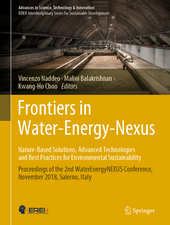Controlling Biofouling in Seawater Reverse Osmosis Membrane Systems: IHE Delft PhD Thesis Series
Autor Nirajan Dhakalen Limba Engleză Hardback – 27 sep 2018
This research focused on assessing the ability of UF and other pre-treatment technologies to reduce biofouling in SWRO systems. An improved method to measure bacterial regrowth potential (BRP) was developed and applied at laboratory, pilot and full scale to assess the ability of conventional UF (150 kDa) and tight UF (10 kDa) alone and in combination with a phosphate adsorbent to reduce regrowth potential and delay the onset of biofouling in SWRO.
The improved bacterial regrowth potential method employs a natural consortium of marine bacteria as inoculum and flow cytometry. The limit of detection of the BRP method was lowered to 43,000 ± 12,000 cells/mL, which is equivalent to 9.3 ± 2.6 µg-Cglucose/L.
The reduction in bacterial regrowth potential after tight UF (10 kDa) was 3 to 4 times higher than with conventional UF (150 kDa). It was further reduced after the application of a phosphate adsorbent, independent of pore size of the UF membrane. Pilot studies demonstrated that the application of tight UF (10 kDa) coupled with a phosphate adsorbent consistently lowered the bacterial regrowth potential and no feed channel pressure drop increase was observed in membrane fouling simulators (MFS) over a period of 21 days. The study also showed that non-backwashable fouling of UF membranes varied strongly with the type of algal species and the algal organic matter (AOM) they release. The presence of polysaccharide (stretching -OH) and sugar ester groups (stretching S=O) was the main cause of non-backwashable fouling.
In conclusion, this study showed that an improved BRP method is suitable for the assessment of SWRO pre-treatment systems and it can be a useful tool to develop potential strategies to mitigate biofouling and improve the sustainability of SWRO systems.
| Toate formatele și edițiile | Preț | Express |
|---|---|---|
| Paperback (1) | 484.08 lei 6-8 săpt. | |
| CRC Press – 16 ian 2018 | 484.08 lei 6-8 săpt. | |
| Hardback (1) | 875.55 lei 6-8 săpt. | |
| CRC Press – 27 sep 2018 | 875.55 lei 6-8 săpt. |
Din seria IHE Delft PhD Thesis Series
-
 Preț: 355.20 lei
Preț: 355.20 lei - 23%
 Preț: 473.10 lei
Preț: 473.10 lei - 17%
 Preț: 257.23 lei
Preț: 257.23 lei - 28%
 Preț: 492.31 lei
Preț: 492.31 lei - 23%
 Preț: 472.25 lei
Preț: 472.25 lei - 13%
 Preț: 322.51 lei
Preț: 322.51 lei - 29%
 Preț: 524.35 lei
Preț: 524.35 lei - 31%
 Preț: 295.46 lei
Preț: 295.46 lei - 22%
 Preț: 399.88 lei
Preț: 399.88 lei - 30%
 Preț: 1015.76 lei
Preț: 1015.76 lei - 17%
 Preț: 268.83 lei
Preț: 268.83 lei - 44%
 Preț: 256.76 lei
Preț: 256.76 lei - 18%
 Preț: 254.47 lei
Preț: 254.47 lei - 25%
 Preț: 339.78 lei
Preț: 339.78 lei - 13%
 Preț: 322.01 lei
Preț: 322.01 lei - 26%
 Preț: 455.79 lei
Preț: 455.79 lei - 22%
 Preț: 399.48 lei
Preț: 399.48 lei - 27%
 Preț: 427.41 lei
Preț: 427.41 lei - 22%
 Preț: 371.52 lei
Preț: 371.52 lei - 26%
 Preț: 373.21 lei
Preț: 373.21 lei - 22%
 Preț: 328.64 lei
Preț: 328.64 lei - 13%
 Preț: 348.86 lei
Preț: 348.86 lei - 22%
 Preț: 369.82 lei
Preț: 369.82 lei - 18%
 Preț: 174.31 lei
Preț: 174.31 lei - 22%
 Preț: 414.78 lei
Preț: 414.78 lei - 23%
 Preț: 454.94 lei
Preț: 454.94 lei - 23%
 Preț: 315.45 lei
Preț: 315.45 lei - 17%
 Preț: 257.23 lei
Preț: 257.23 lei - 13%
 Preț: 296.68 lei
Preț: 296.68 lei - 22%
 Preț: 353.39 lei
Preț: 353.39 lei - 23%
 Preț: 326.95 lei
Preț: 326.95 lei - 13%
 Preț: 348.40 lei
Preț: 348.40 lei - 23%
 Preț: 367.30 lei
Preț: 367.30 lei - 22%
 Preț: 322.47 lei
Preț: 322.47 lei - 27%
 Preț: 425.74 lei
Preț: 425.74 lei - 17%
 Preț: 212.40 lei
Preț: 212.40 lei - 23%
 Preț: 473.94 lei
Preț: 473.94 lei - 13%
 Preț: 322.98 lei
Preț: 322.98 lei - 23%
 Preț: 367.73 lei
Preț: 367.73 lei - 22%
 Preț: 328.22 lei
Preț: 328.22 lei - 23%
 Preț: 350.43 lei
Preț: 350.43 lei - 25%
 Preț: 472.25 lei
Preț: 472.25 lei - 28%
 Preț: 498.58 lei
Preț: 498.58 lei - 23%
 Preț: 349.16 lei
Preț: 349.16 lei - 18%
 Preț: 162.13 lei
Preț: 162.13 lei - 13%
 Preț: 350.29 lei
Preț: 350.29 lei - 28%
 Preț: 550.16 lei
Preț: 550.16 lei - 25%
 Preț: 552.62 lei
Preț: 552.62 lei - 23%
 Preț: 384.59 lei
Preț: 384.59 lei - 18%
 Preț: 175.64 lei
Preț: 175.64 lei
Preț: 875.55 lei
Preț vechi: 1253.49 lei
-30% Nou
Puncte Express: 1313
Preț estimativ în valută:
167.53€ • 174.92$ • 138.66£
167.53€ • 174.92$ • 138.66£
Carte tipărită la comandă
Livrare economică 04-18 aprilie
Preluare comenzi: 021 569.72.76
Specificații
ISBN-13: 9781138381568
ISBN-10: 113838156X
Pagini: 224
Dimensiuni: 174 x 246 mm
Greutate: 0.45 kg
Ediția:1
Editura: CRC Press
Colecția CRC Press
Seria IHE Delft PhD Thesis Series
ISBN-10: 113838156X
Pagini: 224
Dimensiuni: 174 x 246 mm
Greutate: 0.45 kg
Ediția:1
Editura: CRC Press
Colecția CRC Press
Seria IHE Delft PhD Thesis Series
Public țintă
PostgraduateCuprins
1 General introduction
2 Perspective and challenges for desalination
3 Measuring bacterial regrowth potential (BRP) in seawater reverse osmosis using a natural bacterial consortium and flow cytometry
4 Understanding ultrafiltration membrane fouling induced by four marine bloom forming algae
5 The role of tight UF on reducing the bacterial regrowth potential of SWRO feed water
6 Phosphate removal in seawater reverse osmosis feed water: An option to control biofouling
7 General conclusions and future perspective
2 Perspective and challenges for desalination
3 Measuring bacterial regrowth potential (BRP) in seawater reverse osmosis using a natural bacterial consortium and flow cytometry
4 Understanding ultrafiltration membrane fouling induced by four marine bloom forming algae
5 The role of tight UF on reducing the bacterial regrowth potential of SWRO feed water
6 Phosphate removal in seawater reverse osmosis feed water: An option to control biofouling
7 General conclusions and future perspective
Descriere
This study developed the method for measuring bacterial regrowth potential in seawater samples, an effective tool to assess the biofouling potential of seawater reverse osmosis feed water. It was demonstrated that lower algogenic organic matter and phosphate concentrations coincide with lower bacterial regrowth potential and lower rate of head loss development in membrane fouling simulators.














